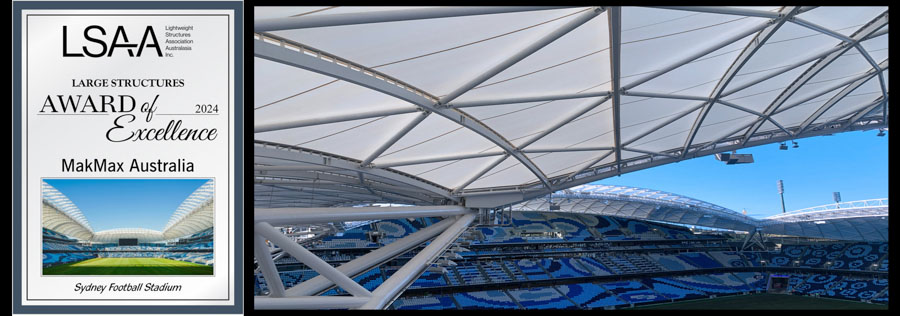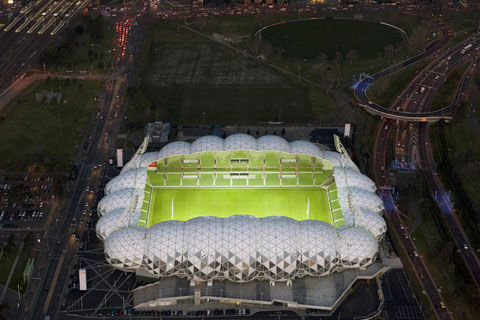2024 LSAA Design Awards Entry Sydney Football Stadium Roof
|
ID NUMBER |
3865 |
|
ENTRY CATEGORY |
3 Large Structures |
|
ENTRANT ROLE |
Design / Engineer / Fabrication / Installation |
|
PROJECT NAME: |
Sydney Football Stadium Roof |
|
APPLICATION: |
Tensile Membrane Stadium Roof |
PROJECT DESCRIPTION:
The Sydney Football Stadium Roof, completed in 2022, has joined the growing list of major international iconic stadiums featuring lightweight tensile membrane roofing. Right from the start of the design phase, the project brief emphasised the integration of key stadium elements – the Stadium Domain, Seating Bowl, Façade, and Roof – into a cohesive architectural language.
The highly visible 26,000 square metre tensile membrane roof uses Chukoh Skytop FGT800 PTFE as the primary cladding element. The lightweight PTFE membrane provides exceptional durability and strength, ensuring a 50+ year lifespan with minimal maintenance.

As well as the PTFE panels, the roof structure also includes 4000 sqm of transparent ETFE along the leading edge. The tensile membrane roof helps to protect sporting spectators and live-concert fans from sun, wind, and rain, while the lightweight diagrid steel structure provides an architecturally stunning arched canopy to amplify the roar of the crowd.
Despite significant challenges posed by the COVID-19 pandemic and record-breaking weather conditions in 2022, the project was completed on schedule in the second half of the 2022 in time for the NRL finals series. The successful installation of 48 PTFE roof panels, 96 ETFE panels, and 900 sqm of vertical PTFE infill panels was achieved through details project planning, offsite prototyping, and strict adherence to health and safety protocols.
The Sydney Football Stadium Roof stands as a testament to innovation, resilience, and excellence in large-scale lightweight tensile membrane construction, setting a new benchmark for future stadium projects worldwide.
THE PROJECT
In late 2019 we became involved with Sydney Football Stadium design management team, which included the nominated construction firm, the project architect, and the project engineers. Our role was to contribute specialised lightweight structural design and engineering expertise in the design phase and ultimately install the tensile membrane roof for the new Sydney Football Stadium.
A major infrastructure project for the NSW government, the project brief mandated that “the key formal elements of the Stadium – the Stadium Domain, Seating Bowl, Façade and Stadium Roof – should also be physically well integrated with each other and exploit the opportunity to articulate a consistent strong and dynamic architectural language.” Further specifications required the roof and roofing elements to provide the transmission of natural light into interior areas, provide thermal resistance, ensure acoustic performance, and offer weather protection to minimise corrosion or deterioration of the stadium's interior elements.
These specifications naturally led to the proposal of a lightweight tensile membrane roof. We proposed PTFE as the primary roof cladding material, given its suitability for meeting the project brief, architectural design requirements, and expected project design life and functionality.
DESIGN & ENGINEERING
Leveraging our extensive experience with tensile membranes, we recommended modifications to the original roof profile to maximise its strength by using the tensile fabric as a core structural component rather than merely a cladding material.
Our in-house engineers worked collaboratively with the project design team using a comprehensive 3D parametric model of the stadium roof. The parametric design approach allowed us to apply rules and instantly generate updates across the entire roof when any changes were made to the structural elements. This real-time information was then communicated to the project team, architects, and our international fabrication teams.
MATERIALS
Designed for a lifespan of over 50 years, the strength and durability of the PTFE fibreglass membrane were critical to the project’s long-term legacy. Compared to other translucent roofing materials such as polyester fabrics or polycarbonate sheeting, the use of PTFE offered the stadium a distinct advantage in terms of design life.
We selected Chukoh Skytop FGT800, which incorporates B filaments just 3 microns in diameter—the finest fibreglass membrane filament available. As the diameter of the filament decreases, more individual strands are used in the base cloth weave, thereby increasing the tensile strength per unit area. Given that the largest roof panels on the stadium measure 15 metres wide and over 40 metres long, the use of this high-strength fabric was essential for withstanding the significant tension loads applied to the membrane.
In addition to its high strength and extended lifespan, the low-surface tension of the PTFE coating helps the Skytop FGT800 membrane resist dust, dirt, and pollution build-up. This makes PTFE a low-maintenance roofing material, a major advantage for large-scale public infrastructure projects like the Sydney Football Stadium.
Alongside the main PTFE roofing element, the leading edge of the roof features an extended section covered in 4,000 square metres of completely transparent ETFE film. ETFE film allows sunlight and UV rays to penetrate the leading edge of the roof, promoting natural turf growth and reducing the need for artificial lighting during winter, while still protecting spectators from the elements. At only 250 microns thick and weighing 20 times less than glass panels, ETFE film is an ultra-lightweight material. Its use minimises the secondary structural elements required to support the clear roof panels - a significant benefit when installing a large span roof with minimal supporting columns.
A further 900 square meters of vertical PTFE infill panels were installed to interface between the two key components of the roof.
The combination of the translucent PTFE membrane and the clear ETFE film is both practical and visually striking, enhancing the stadium’s architectural appeal and showcasing the impressive design advantages of lightweight structure techniques.
INSTALLATION
As with any large-scale stadium project, the Sydney Football Stadium involved hundreds, sometimes thousands, of small, repetitive details, with no two details being exactly the same. The sheer number of connection details, all with slight variations in the whole roof was enormous. Maintaining a strict attention to detail from start to finish, through every step of the process, was both critically important and the biggest challenge on this project.
The roof consisted of 48 massive PTFE panels supported by a lightweight diagrid steel frame. The fabric panels were fixed to the steel roof trusses and support beams using over 11 km of ultra-light, high-strength aluminium tensioning hardware. While similar in shape and fabrication requirements, each panel had unique geometry or size based on its location around the roof. Our constantly updated 3D parametric model facilitated seamless communication and coordination with fabricators, installers, and the project management team.
Additionally, we designed and installed 96 ultra-lightweight ETFE panels, with each panel incorporating integrated stainless-steel cabling for strength and support. Each of the 1,100 cables (totalling over 5 km in length) needed to be fabricated to the correct length based on the exact location and geometry of the panels.
Even with live 3D modelling at our disposal, to avoid encountering any surprises when installing the roof sections over 30 metres above ground, we constructed a series of full-scale offsite mock-ups in our Queensland factory. These mock-ups included many of the roofing sections, panel connections, guttering, and various other interfaces. They were built to practically test our designs, such as water-flow testing on our guttering systems to ensure they could handle the expected volumes of rainwater. The mock-ups were also used to test small connection details, ensuring that when the various fabric and hardware components from multiple suppliers arrived on-site, we had already anticipated and resolved any installation challenges or questions. This also provided time to implement contingencies in case something was overlooked or unexpected issues arose.
In a public works project of this scale, safety was paramount, particularly when installing ETFE panels at heights ranging from 36 to 46 metres. Our team operated from elevated work platforms (EWPs) and used a specially developed netting system, adhering to strict health and safety protocols while coordinating with other trades working simultaneously on the stadium.
The project faced unprecedented challenges due to the COVID-19 pandemic, including border closures, freight disruptions, site shutdowns, extended sick leave periods, and stringent on-site safety protocols. Adding to the pandemic disruptions, 2022 was one of the wettest years on record in Sydney. With nearly all our installation elements taking place high above ground and exposed to the worst of the wind and weather, many days were lost to weather-related closures, making on-site work impossible.
Despite these obstacles, the stadium opened on schedule for the final round of the 2022 NRL season, thanks to the dedication and hard work of our installation teams and the efficiencies achieved through parametric 3D modelling and offsite prototyping.
THE RESULT
The Sydney Football Stadium Roof project is a testament to our resilience and innovation in the face of unprecedented challenges. Throughout the pandemic, we navigated material price rises, global supply chain issues, cross-border restrictions, and labour shortages. These challenges prompted us to develop new processes and installation methodologies, ensuring the project was completed on time.
The final result is an outstanding achievement, showcasing the successful integration of a tensile membrane roof into a major public infrastructure project. We are incredibly proud to have contributed to this iconic stadium, setting new standards in lightweight structural design and engineering.
COLOUR IMAGES
3865_SFS-Roof_01_hero.jpg
3865_SFS-Roof_02-interior.jpg
3865_SFS-Roof_03-interior.jpg
3865_SFS-Roof_04-interior.jpg
3865_SFS-Roof_06-exterior.jpg
3865_SFS-Roof_05-interior.jpg
3865_SFS-Roof_07-install.jpg
3865_SFS-Roof_08-install.jpg
3865_SFS-Roof_09-install.jpg
3865_SFS-Roof_10-install.jpg
3865_SFS-Roof_11_Closeup-ETFE.jpg
3865_SFS-Roof_12_Closeup-PTFE.jpg






